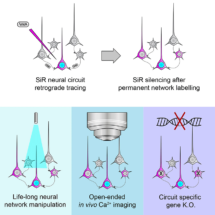
Neural networks, circuits of neurons, are emerging as the fundamental computational unit of the brain and it is becoming progressively clearer that neural network dysfunction is at the core of a number of psychiatric and neurodegenerative disorders. Yet our ability to target and study specific neural networks remains limited. Until now Rabies virus, which can jump synapses, has been used to investigate neural networks. However the virus causes neuronal death resulting in a very short time window in which the networks can be studied. Work by Marco Tripodi’s group in the LMB’s Neurobiology Division has resulted in a novel approach which provides, for the first time, a life-long ability to study neural networks, without affecting their normal physiology.
Ernesto Ciabatti and Marco Tripodi designed a self-inactivating Rabies virus (SiR), which retains the ability to jump synapses, thus reaching the entire neural network, but does not cause neuronal death. During the initial viral infection, the neurons in the network are permanently labelled and genetic manipulation is made possible. The virus can modify the neurons so they constantly produce a fluorescent protein, allowing the network to be visualised. Crucially, Marco’s group modified the virus by adding a tuneable switch – the SiR contains selected proteins which can be targeted for degradation. Without these proteins, the virus is unable to replicate and switches off after the initial infection, thus avoiding death of the neurons and leaving them permanently labelled but virus-free.
Progress in science often depends on new techniques and with this novel approach it is now finally possible to genetically manipulate neural networks and follow their behaviour over prolonged periods of time. This will be important at a basic science level to understand how the brain works, and excitingly will also offer insight into how neural networks change upon experience and learning. In addition, this new technique will pave the way to the engineering of the genetic content of selected neurons within a network, which would be extremely useful in neurodegenerative and psychiatric disorders where disease genes could be targeted, with therapeutic potential.
This work was funded by the MRC and European Research Council.